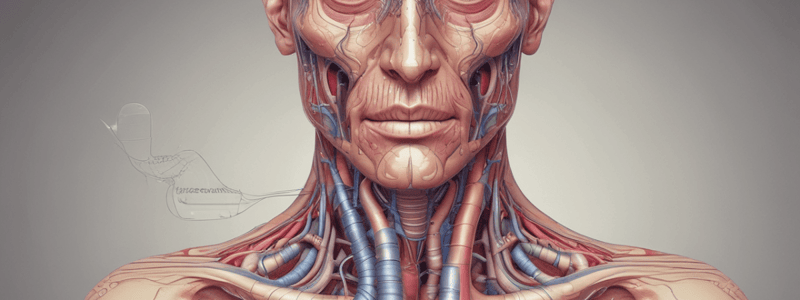Podcast
Questions and Answers
Which cranial nerve is responsible for the innervation of the Parotid gland?
Which cranial nerve is responsible for the innervation of the Parotid gland?
- X cranial nerve
- VII cranial nerve
- IX cranial nerve (correct)
- V3 cranial nerve
What is the primary function of the propulsive contractions mediated by the PS nerves in the myenteric plexus?
What is the primary function of the propulsive contractions mediated by the PS nerves in the myenteric plexus?
- To mix the substances
- To move the bolus further along the tube (correct)
- To slow down the movement of the chyme
- To relax the muscles of the tongue
Which muscles are responsible for mechanical homogenization during the oral phase of swallowing?
Which muscles are responsible for mechanical homogenization during the oral phase of swallowing?
- Extrinsic lingual muscles
- Muscles of the palate
- Muscles of the jaw
- Intrinsic lingual muscles (correct)
How long does it take for the bolus to travel from the pylorus to the ileocecal valve?
How long does it take for the bolus to travel from the pylorus to the ileocecal valve?
Which nerve provides innervation to the mandibular muscles of the jaw?
Which nerve provides innervation to the mandibular muscles of the jaw?
What is the location of the submucosal plexus in the intestinal wall?
What is the location of the submucosal plexus in the intestinal wall?
What is the function of the myenteric plexus in the intestinal motility?
What is the function of the myenteric plexus in the intestinal motility?
What type of muscle is innervated by the myenteric plexus?
What type of muscle is innervated by the myenteric plexus?
What is the role of mechanoreceptors in the myenteric plexus?
What is the role of mechanoreceptors in the myenteric plexus?
What is the diameter range of the fibres that interconnect the two muscle layers in the intestinal wall?
What is the diameter range of the fibres that interconnect the two muscle layers in the intestinal wall?
Which type of neurons carry sympathetic fibres to the myenteric and submucosal plexuses?
Which type of neurons carry sympathetic fibres to the myenteric and submucosal plexuses?
What is the primary function of the myenteric plexus?
What is the primary function of the myenteric plexus?
What is the effect of the submucosal plexus on the submucosal muscle?
What is the effect of the submucosal plexus on the submucosal muscle?
What is the purpose of segmentation contractions in the gastrointestinal tract?
What is the purpose of segmentation contractions in the gastrointestinal tract?
What is the effect of VIP (vasoactive intestinal peptide) on the pyloric sphincter and the ileocecal valve?
What is the effect of VIP (vasoactive intestinal peptide) on the pyloric sphincter and the ileocecal valve?
What is the primary mechanism by which the central nervous system influences primary peristalsis in the esophagus?
What is the primary mechanism by which the central nervous system influences primary peristalsis in the esophagus?
What is the role of VIP and NO in secondary esophageal peristalsis?
What is the role of VIP and NO in secondary esophageal peristalsis?
What is the response of the esophageal muscle layers above the bolus level during secondary peristalsis?
What is the response of the esophageal muscle layers above the bolus level during secondary peristalsis?
What is the primary function of the dorsal motor nucleus in the context of esophageal peristalsis?
What is the primary function of the dorsal motor nucleus in the context of esophageal peristalsis?
What is the trigger for the activation of secondary esophageal peristalsis?
What is the trigger for the activation of secondary esophageal peristalsis?
What type of muscle is present in the upper third of the esophagus?
What type of muscle is present in the upper third of the esophagus?
Which nerves are responsible for the innervation of the striated muscle in the upper esophagus?
Which nerves are responsible for the innervation of the striated muscle in the upper esophagus?
What is the name of the muscle that relaxes to allow the passage of food into the esophagus?
What is the name of the muscle that relaxes to allow the passage of food into the esophagus?
What is the term for the peristalsis that occurs in response to esophageal distension?
What is the term for the peristalsis that occurs in response to esophageal distension?
How long does it take for the food bolus to pass through the esophagus?
How long does it take for the food bolus to pass through the esophagus?
Flashcards are hidden until you start studying




